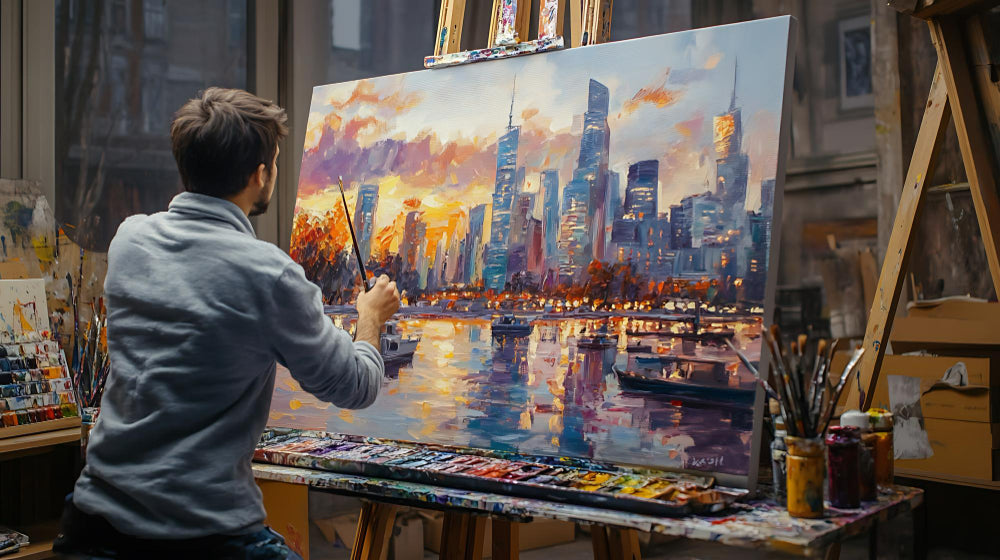
The world's top 10 most famous drawings and what makes them iconic
Share
The world's top 10 most famous drawings and what makes them iconic.
Drawings have been one of the oldest forms of artistic expression and can express emotions, ideas, and even stories. Much like history, some drawings have withstood the test of time, not only to depict the artist's merit but also for their symbolization in culture. Here are ten of the most famous drawings and what makes them so iconic and enduring in art.
1. "Vitruvian Man" by Leonardo da Vinci (1490)
This type of art is a work of excellence in itself by putting forth the blend of science and art. A human body drawn in two superimposed poses with the arms and legs stretched outwards. The work "Vitruvian Man" symbolizes the Renaissance ideal of humanism and embodies da Vinci's studies in anatomy and proportion. Detailed characteristics and perfect symmetry in "Vitruvian Man" express this quest for knowledge and beauty.
2. "The Girl with a Balloon" by Banksy (2002)
It is a street art mural depicting an extended hand of a young girl towards a red heart-shaped balloon. The simplicity of the drawing, and the emotions the drawing holds, really connote hope and loss. After anonymity through the said author, Banksy, and after stunt stunts, the piece actually put itself in contemporary art history by self-destructing during an auction.
3. "Study of a Horse" by Leonardo da Vinci (1510)
Da Vinci's studies of horses may be minute but are very telling regarding his interest in movement and anatomy. This sketch only highlights his style while capturing the real physical attributes but also the spirit of this horse. It also points out that da Vinci believed art was an exploration of and an understanding of the real world.
4. "The Dream" by Pablo Picasso, 1932
This work is a representation of the last phases of Picasso, and he again uses bright colors and again produces abstractly formed figures. The curves of this drawing can be expressions of love and longing. At the same time, it becomes an illustration of how he transformed classic portraiture to modern art that made it and this piece a legend.
5. "Self-Portrait with Cropped Hair" (1940) by Frida Kahlo
A stunningly beautiful drawing, Kahlo is the artist depicting herself after a tough break-up. She cuts her hair in a gesture of freedom and protest. Using symbolism, she portrays the strength of emotions concerning personal identity and the strength of women.
6. "The Scream" (1893) by Edvard Munch
Though the artwork is a painting, Munch's original drawing of "The Scream" is also iconic. It captures the essence of angst because of its haunting figure set against a turbulent sky. This drawing, therefore, is universally relatable and personifies human emotion and vulnerability.
7. "Mona Lisa" Sketches by Leonardo da Vinci (1503-1506)
Studies and sketches that eventually led to the finished version of "Mona Lisa" are a brilliant example of the caution taken by da Vinci. These sketches not only present an aesthetic example but also take one through the process in its creation, which is a perfect insight into the development of one of the world's most popular portraits.
8. "Nighthawks" by Edward Hopper (1942)
The initial sketches Hopper made of the painting "Nighthawks" are amazing. The work is a portrayal of themes like urban isolation and loneliness, capturing a moment of stillness in a populous city. Its mainstream depiction of modern life has influenced countless artists and remains a symbol of American art.
9. "The Sketchbook of Leonardo da Vinci"
From anatomy to inventions, the number of subjects is unending with this collection of drawings from his great works. Each page paints the insatiable curiosity and creativity of da Vinci, making it an iconic testament to the breadth of genius this man possessed. The influence of this sketchbook lies in its innovating ideas and unique techniques in art.
10. Studies for "Guernica" by Pablo Picasso (1937)
The sketches that led to Picasso's monumental painting, "Guernica," well illustrate the intensity of the emotions of war and suffering. They indicate his reaction to the Spanish Civil War, and their powerful imagery has come to symbolize anti-war sentiment.
These legendary drawings not only speak of the unifying characteristics of each master but also represent the cultural and historical backgrounds in which they were created. Their work has deeply influenced later generations of artists and admirers of fine art and will be shown to enjoy the work for years to come.
The world's top 10 most famous drawings and what makes them iconic








